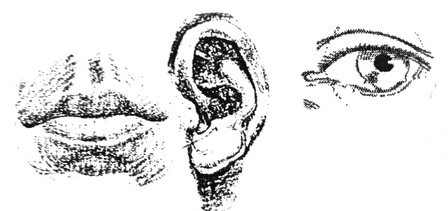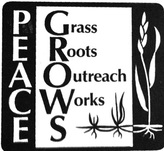Active listening and using I-Statements are essential skills.
1. Think about a situation in which you have not been listen to. How did it feel?
Perhaps your answer describes feeling hurt.
Perhaps your answer describes feeling hurt.
Hurt: Painful, Injure, Distress, Harm
2. How do you feel when someone listens well to you?
Perhaps your answer described feeling respected.
Perhaps your answer described feeling respected.
Respect: Esteem, Regard, High Opinion, Admiration, Honor
The Listening Chart:
|
Violently
|
Nonviolently or Actively
|
LISTENING VERSUS HEARING
|
In this fast-paced drive-thru world we live in, the Chinese character for the verb "to listen" takes on an interesting significance. in trying to explain the difference between listening and hearing, nothing does it quite as artistically, poetically, or simplistically as this ancient design.
By integrating representations of not only our ears, but our eyes, our heart, and the selfless act of undivided attention into one holistic character, the Chinese have truly captured the essence of "listening." |
|
Two most interesting examples are historical but little known.
Case Studies: |
QUAKER JUSTICE FORCES PEACE
Why wasn't William Penn scalped? The early American colonists took land from the Native Americans by force and taught the Native Americans the art of scalping. The colonists could not speak the language of the Indians; communication was difficult.
By contrast, when William Penn was given his Pennsylvania grant he began at once to learn the Native American language. At his initial meeting with them, he spoke peaceably and in their tongue. Instead of taking their land by force, he paid for it fairly, clearly defining the boundaries. He asked that the Native Americans report any future injustices on the part of Pennsylvania colonists. As Voltaire said, this was the only treaty never written down and the only one never broken. As a result of these just relationships, a real friendship was forged. When Quakers were gone from home, sometimes for days at a time, who took care of their children? The Native Americans were their babysitters, sometimes members of the same tribes were scalping other colonists. The Quaker latchstrings were always open for Native Americans to come and go day and night with complete mutual trust. As Pope Paul said, "you want peace, then work for justice." See The Quiet Battle (Sibley), pp. 210-217 From the chart in session 1, we can note that good public relations, respect, and appropriate conduct was used. In addition, William Penn used good listening techniques, as discussed in this session. |
LINGUISTIC MIRACLES
How Frank Laubach bridged wide chasms. Frank Laubach, founder of the "Each One Teach One” campaign which is credited with bringing literacy to millions of human beings, felt he was 'getting nowhere' with the Philippine Moros. He didn't know what to do about this savage people.
Then he realized that he might have been hiding from himself (but not from the Moros) a sense of racial, cultural and religious superiority. Immediately he passed around the word that he wanted to study the Moros' sacred book, the Koran, under their leadership. A crowd of Mohammedan teachers swarmed around his tent by the next morning. With help, Laubach was soon mastering the language of the Moros, which had never been printed. Eventually, he stumbled on the discovery that only three words contained all the consonants necessary to speak the language. Each word, "mother," "hand," and "work," had four syllables. From this point, it was simple to construct reading charts. Laubach has now successfully carried this technique to many other languages. As he left the Philippines, the Mohammedan leader prayed that his American friend would have the blessing of Allah as he went around the world, "introducing to less fortunate nations the method we (Moros) helped him make into the easiest lessons in the world for teaching people to read." See Courage in Both Hands (Hunter) pp. 85-89 All parties knew all the facts in this case by appropriate communication from "universal words". In addition, it focused on the importance of persistence and patience, exemplary conduct, public relations, and integrity and humility. Again, refer back to the chart in session 1 for these techniques. |
GO AND PRACTICE Active Listening: an activity that really works
|
Do the listening exercise in circles of 4-5 people with one ball (or any item) to pass around each circle.
Rules for the exercise: 1. To speak at all, one must hold the ball! 2. First speaker states position clearly and concisely, then passes the ball on to the left. 3. New holder, first repeat what was said to the satisfaction of the first speaker. Then new holder states own position and passes ball to the left. 4. Repeat the process around the circle as much as time allows. Then return to the large circle. |
Case Study: |
FAMILY CIRCLE
benefits from listening exercise. I tried the listening technique demonstrated in class last week with my family. We used a beanbag as a prop and sat in a circle in the Iiving room. The question I posed to the group was, ”How can we work together as a family?”
I took the first turn. My suggestion was to have a message center or bulletin board. My six-year-old son David was next to hold the beanbag. He repeated my suggestion and he added that he thought we should all help each other doing chores around the house. The beanbag next went to Christen, my four~year-old who was too shy to talk at first but with a little coaxing, we got her to say she wanted a bulletin board. |
My husband, John, had the next turn. He is usually a complainer so he had a bit of trouble not complaining and trying to come up with a positive suggestion, but finally said, ”Teamwork.”
Brian, age eight, was next. He restated his dad’s idea and added that he thought that we should stop fighting so much and then we could work together better. Lastly, I took the beanbag and repeated Brian's suggestion. The technique worked fairly well. Christen was too young perhaps to understand how to participate, but with time I think she would become more confident and talk in her turn. This experience was also good in that one person was not allowed to dominate the conversation and there was only one topic being discussed at one time, instead of two or more. In many family conflicts, going off on more than one topic can hinder anything from being done. Submitted by a parent from the lnterparish School of Religion, Akron, Ohio, while taking the ALTERNATIVES TO VIOLENCE course. Resolving human problems nonviolently requires getting the facts which includes all feelings and perceptions as well as what happened. |
...Of course, anger must be recognized for peaceful alternatives to work
1. Listen carefully to oneself to understand as clearly as possible one’s own desires and needs in the specific situation.
2. Express those needs to the other person or group, either in conflict or who can help solve the problem. These should be made in clear statements which, mainly, is for handling own anger.
3. Then nonviolently and actively listen to their facts, opinions, perceptions; respond to them and decide how to proceed next.
Note:
Anger, like conflict, is all right. In fact, both are good in themselves. They help get out facts without which problems cannot be solved. The bad only results when they are not handled properly such as violently instead of nonviolently.
2. Express those needs to the other person or group, either in conflict or who can help solve the problem. These should be made in clear statements which, mainly, is for handling own anger.
3. Then nonviolently and actively listen to their facts, opinions, perceptions; respond to them and decide how to proceed next.
Note:
Anger, like conflict, is all right. In fact, both are good in themselves. They help get out facts without which problems cannot be solved. The bad only results when they are not handled properly such as violently instead of nonviolently.
VERBAL EXPRESSION: HANDLING OUR ANGER NONVIOLENTLY
|
Communication Facilitators DOs
Use statements such as:
Also use:
a) Agree with part of an argument b) Ask for more specific criticism c) List options and choose from them
|
Communication Obstructors DON'Ts
Also do not:
DOs and DON'Ts submitted by Sr. Rose Dailey, who learned these at a communications workshop sponsored by the Ursuline Sisters of Youngstown |
|
Video of the information found in the above charts!
|
Using "I"
Statements |
A Rhyming Response to Anger
|
How would this rhyme have helped Kermit with his anger?
|
Case Studies: |
AN ABERRANT STUDENT
can be nudged to improve. Recently I had a problem with a student's behavior and attitude. I planned in advance what I wanted to say and how I would say it. I decided to use statements and to concentrate on speaking calmly and slowly.
When the student came in, I was able to speak with him alone for about twenty minutes. He hung up his jacket before I started to talk but, when I started to speak, he stayed by the closet door, leaving it open. I started out telling how I felt about what was going on and was very careful to use "I" statements. As usual he became very angry and once went in to get his jacket to leave. I continued to talk to him calmly and did not mention his move to leave. After we talked for about ten minutes, he finally, on his own, moved to his seat and continued to talk. When we were out of time in the classroom, we moved to the hall and wrapped up the conversation. While long-range problems were not solved, his behavior and attitude were greatly improved and have stayed good for several days. During the discussion, the student became upset, as he usually does, but did not storm out as he is likely to do. I really think the "I" statements, planning ahead and the calm, controlled atmosphere greatly influenced the outcome of the discussion. Submitted by an Akron City teacher white taking the ALTERNATIVES TO VIOLENCE course. This case study relates to both the use of "I" statements and also assertive style. The teacher was direct and honest but not offensive. The teacher also showed vulnerability to the student. |
NEW APPROACH
offers something to gain. Every weekend my family faces what every other family faces . . . an argument over a dirty house. Try as I may I always lose it. It seems there are so many activities and overwhelming chores.
This week instead of threatening, insisting that I need a clean house, and putting all three of my children in their place because they did not handle their responsibilities, I tried something different. At our family meeting, I told them how I felt—overloaded and angry because of all the "stuff" I had to do to keep things in order. We discussed how they felt about my anger, about their feelings and what possible solutions we could implement. We came up with two solutions: 1) an infraction list and 2) attitude enhancement list. After discussing the problem and implementing the solution, the week was fun. And because everyone did his or her part, the weekend workload was cut in half. Submitted by a parent from the lnterparish School of Religion, Akron, Ohio, while attending the ALTERNATIVES TO VIOLENCE course. The mother in this case study avoided blaming and took responsibility for her feelings in this situation. She also used "I" statements and open ended questions. "What would you be willing to do?" These tactics allowed the situation to be more effectively addressed. |
Review and Reflect
Major Point to Remember:
Active listening and using I-Statements are essential skills
To Reflect: Optional Activities:
Materials located on the "Extra" page for applications #1 & #2
#1: Analyze at least two Case Studies: 5C, 5D, 5E, 5F, 5G, 6B, 6D
#2: Movie Assignment: View "Speak" and answer the corresponding questions
#3: Application:
If peaceful conflict resolution were our habit, we could decide a response, consider consequences, and plan the follow-through in a very short order – moments. As we learned with active listening, we all need practice and more practice.
Look at the following exercise about changing inflammatory statements to I-statements.
#2: Movie Assignment: View "Speak" and answer the corresponding questions
#3: Application:
If peaceful conflict resolution were our habit, we could decide a response, consider consequences, and plan the follow-through in a very short order – moments. As we learned with active listening, we all need practice and more practice.
Look at the following exercise about changing inflammatory statements to I-statements.
| "Handling Anger" Activity Download |


